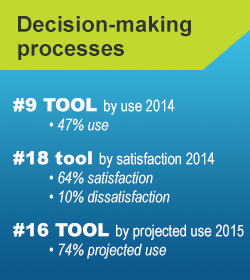Decision-making tools help organizations identify all the activities that must take place for a decision to be made and executed well. Using these tools, organizations determine and define the roles that individuals will play in decisions of different types.
There are several decision-making tools nonprofit leaders can use, usually with acronyms for the roles that individuals can take on during the decision-making process. For example, RAPID:
- "R" stands for "recommender"—the person who drives the process.
- "A" is for an individual who needs to "approve" a recommendation (or can veto it).
- "P" stands for "perform"—the person who carries out the decision once it has been made.
- "I" stands for "input." An "I" must be consulted, but does not have a vote or veto.
- "D" means "decide." The "D" has final authority to commit the organization to action.
Other decision-rights tools include:
- ASICK (Accountable, Support, Inform, Consult, Okay)
- CAIRO (Consulted, Approves, Informed, Responsible, Out of loop)
- IMRN (Input, Make, Ratify, Notify)
- LACTI (Lead, Accountable, Consult, Tasked, Informed)
- RACI (Responsible, Accountable, Consulted, Informed)
- REDI (Responsibility, Execution, Decision-Making, Influence)
How it's used
A clear understanding of decision roles and structures, or "decision rights," is an important component of an effective organization. Organizations are often faced with critical decisions, of both the major-and-infrequent variety (e.g., establishing a five-year strategy, developing or closing major programs or services, launching or exiting partnerships) and the smaller-but-more-frequent type (e.g., budgeting, hiring, and staffing). Unstructured decision-making processes and roles can create bottlenecks. Whether applied to the entire organization or just to specific programs, departments, or decisions, clear decision rights help organizations to:
- Make more effective decisions by giving authority and accountability to a single decision-maker
- Make more efficient decisions by including only necessary participants in the process and assigning clear responsibility to the driver of the process
- Increase transparency about staff roles in the process
- Reduce conflict by increasing role clarity
Methodology
Introducing a decision-rights tool is a multistep process:
- Introduce the concept and tool: Ensure everyone in the organization understands the goal of clarifying decision-making roles, the specific tool that will be used (e.g. RAPID), and the process for rolling it out.
- Identify key decisions and diagnose problems: Select a handful of key decisions causing the organization pain and identify what is currently holding these decisions back.
- Apply the tool to a few key decisions: Clarify how these key decisions should be made in the future, using the decision-rights tool to redesign the process. Assign clear roles ("R," "I," and so forth) to each person involved in the decision-making process. Begin making these decisions in the new way. Assess the improvements and modify roles as necessary.
- Roll it out more broadly: After piloting the tool on a few key decisions, use the same process to clarify all other critical decisions within the organization.
- Step back and review the whole: Continue to assess whether decisions are being made in an efficient and effective manner. As the organization evolves or grows, the roles may need to be reassigned.
Related topics
Additional resources
Five Ways that Nonprofits Can Make Decision Making More Inclusive—and More Effective
Nonprofits are emphasizing inclusion to make their decision-making processes more effective. For many, it’s also a means to an end of achieving more equitable outcomes.
The RAPID Decision Making Tool for Nonprofits
The RAPID® tool for decision making can help a nonprofit spell out roles to improve its organizational decision-making process.
Who Has the D?: How Clear Decision Roles Enhance Organizational Performance
This seminal article explains the power of clarifying decision-making roles and processes to strengthen organizations.
Examples and case studies
Boys Town: Clarifying Decision-Making Roles Between Headquarters and Sites
This case study shows how Boys Town's leaders used RAPID to help them clarify decision-making roles between headquarters and sites.
Aspire Public Schools: Building the Organizational Capacity for Healthy Growth
This article explains how leaders at Aspire Public Schools used RAPID to clarify decision-making roles as part of their efforts to strengthen the organization.


